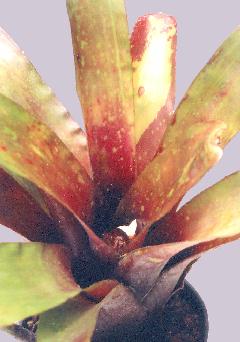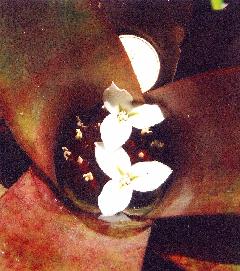

It was in 1990 when Australians first saw a plant called Neoregelia simulans. It had been collected in Brazil by Marg McNamara from NSW and I don’t know who identified it. It could not have been Elton Leme because he knew what it should look like. In 1993 it was in Adelaide and by 1994 it was with John Catlan in Qld. It is a reliable pupper so would have spread to all parts of Australia. A comment at the time was that the flowers were scented. Whoever identified it must have gone from the meagre description in Smith and Downs based on fragments!! In 1994 I did take the inflorescence to pieces but could find no real conflicting evidence to the data in Smith & Downs. Since then the plant has just grown and flowered without being "butchered" until now !
In my thirst for knowledge I found out that Pereira and Leme had in fact written an amended description of N. simulans in Rev Brasil Biol. in 1985. The hardest part was finding the publication but perseverance won out. The easy part was translating it from Latin! The article was headed ‘Emenda Necessaria’ which was the case because of the missing bits in Smith & Downs. Here I found amongst other things that the petals were lilac and narrow whereas our plant had white broad petals with a little green line near the centre. A photo showing what N. simulans looks like is on page 25 of Elton Leme’s ‘Bromeliads in the Brazilian wilderness’ 1993.
This sent me on a wider search and I chanced upon Harry Luther’s article on Neoregelia laevis forma maculata in Journ. Brom. Soc. 51(6): 269. 2001. Why had this not rung bells? Perhaps we get set in our ways as to what a species looks like and we knew that N. laevis never had spots on the leaves!
The problem now, will be to convince others that N. simulans is not in Australia unless it has crept in behind my back. The plant we have is N. laevis but I leave it up to you to decide if the leaves are maculate enough to call it forma maculata.

